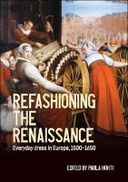Explore

This book investigates how fashion developed among ordinary Europeans in the early modern period and transformed the ‘look’ and experience of fashion – visually and materially – at popular levels of society. Combining evidence from visual, written and material evidence with material hands-on experimentation and historical reconstruction, it explores what were the key elements of fashion among ordinary artisan families, such as among barbers, bakers, shoemakers, innkeepers and booksellers, shedding new light on popular taste and the dissemination, transformation and adaptation of fashion in Europe in 1500-1650. The book shows that the growing range of new fashion -sensitive innovations, such as ribbons, knitted stockings, imitation pearls, new light silks and mixed imitation fabrics provided a new dynamic ability for men and women way below the nobility to experiment with fashion, making desired and rare objects accessible across social classes. Yet, everyday artisan fashion was not limited to cheap substitutes. By strategically placing fine accessories, exquisite jewellery and ornamental ribbons and trimmings in the most prominent areas, even individuals of modest means such as blacksmiths, gardeners or rural women were able to actively engage in fashion and incorporate prestigious and fashionable elements such as silk, fur, silver buttons, gold, pearls and lace into their dress. This creative and innovative approach to fashion, during a time when the traditional hierarchy of clothing to display social status, based on financial value of textiles, became questioned, highlights the complexity of how dress functioned in the early modern period.
This book is included in DOAB.
Why read this book? Have your say.
You must be logged in to comment.
